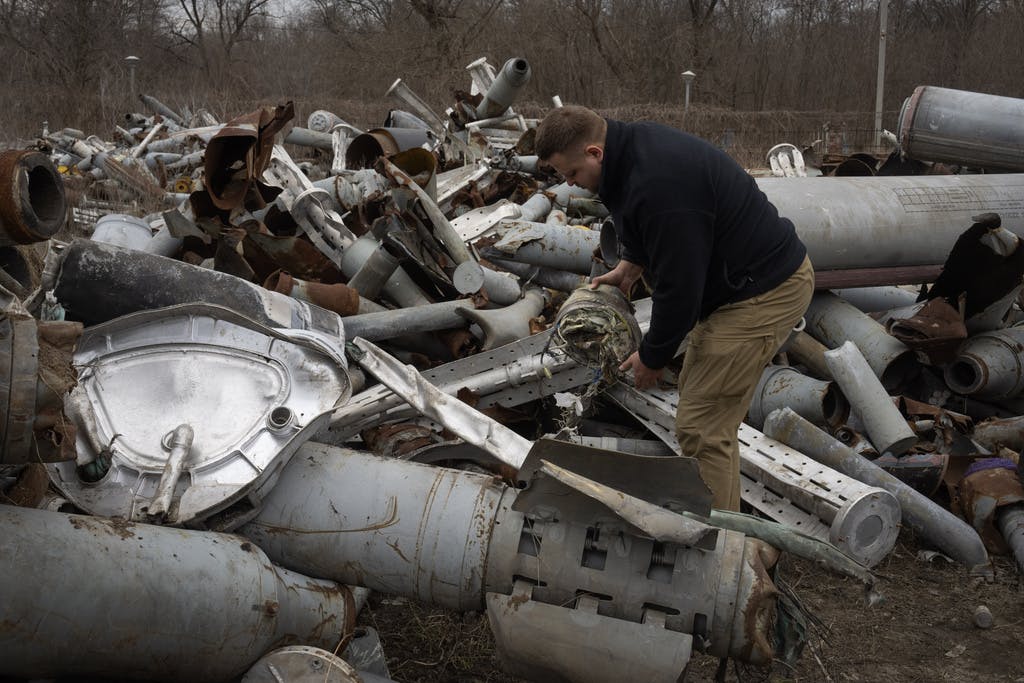An Appetite for Destruction: Russia Ramps Up Glide Bomb Production, Portending More Misery in Ukraine’s Embattled East
Russia’s war economy includes retrofitting old bombs to make them more lethal on the battlefield — with a big impact on eastern Ukraine in particular.

As Ukraine ramps up production of its own weaponry, including, notably, mortar shells, Russia is making bigger bombs. The Russian defense minister, Sergei Shoigu, visited last week a factory at Nizhny Novgorod that’s turning out a new range of glide bombs that weigh 3.3 tons each.
“Russia began mass production of FAB-3000 aerial bombs in February,” Mr. Shoigu boasted during his inspection.
More significantly, the Russians intend to use them — and that spells more gloom for Ukraine, nearly a quarter of which is under Russian control. If momentum along a 620-mile front line has in recent months swung back in Russia’s favor, the rolling out of sophisticated new bombs indicates that Mr. Putin is only digging in his heels.
For now, absent any meaningful talk of negotiations from either side, it appears that the weapons will be doing most of the talking — and the Russ war machine is favoring size over subtlety. The FAB-3000s are reportedly twice as heavy as the more plentiful FAB-1500s, which are themselves three times heavier than existing FAB-500s.
Those bundles of explosives are already tearing up the skies above eastern Ukraine. According to Ukraine’s defense ministry, since February 1 of this year, Russian fighter-bombers have unleashed some 3,500 FAB bombs.
The destructive power is much higher than artillery shells. The 500-range FABs pack 661 pounds in TNT equivalent, and the 1500s pack about 1,543 pounds of explosive power. That punch compares with that of the British Storm Shadow cruise missiles that Kyiv is already using, but the bombs reportedly cost less to make.
More troublingly, it appears that the Russian military is likely to start using these bombs more frequently than it did in the initial phases of the invasion. That is because bombers had to get close to their targets in order to drop their payloads, but most of the areas targeted were already saturated with Ukrainian air defenses.
The Russian workaround, as it were, was the Iranian-made Shahed drone, but with an explosive charge of about 88 pounds each a drone doesn’t stack up to the damage that a bigger bomb can do. Starting last year, the Russians began converting older “dumb” FAB gravity bombs into glide bombs.
This is done by outfitting them with pop-out wings and satellite guidance systems — meaning that, unlike before, they can hover more than 40 miles away from their intended targets. In doing this bit of upcycling, according to a Forbes report, “the Russians produced rough analogues of the American Joint Direct Attack Munition and French Hammer glide-bombs.”
A trooper with the Ukrainian 3rd Assault Brigade, which covered the Avdiivka garrison’s retreat last month, stated on X that there was “a feeling that this is the largest number of aerial bombs on such a piece of land in the entire time of the existence of mankind,” and that “these bombs completely destroy any position.
All of that is what helped Russia to capture the fortified eastern town of Avdiivka in mid-February. The FABs were according to multiple reports being dropped at numbers ranging from 60 to 80 a day, and with devastating impact. Where there was once a town there is now mostly rubble.
And now comes more trouble. Russia has on tap vast stocks of easily convertible bombs left over from the old Soviet days. Plus, according to the open source intelligence site Oryx, since Avdiivka fell the Ukrainians have lost two American Patriot missile launchers and a Norwegian NASAMS surface-to-air missile launcher.
The Russians have had a measure of success targeting Ukraine’s anti-aircraft systems with their Tornado-S multiple rocket launchers. Without getting overly technical, the Ukrainian front line is now more exposed to heavy munitions drops by Russian Sukhoi Su-57s — a twin-engine stealth multirole fighter aircraft — than, this far into the conflict, they should be.
The Ukrainian army has used guided bombs of its own, sometimes with Western logistical support and with some dropped from their own MiG-29 fighter aircraft. The persistent problem is that while the Ukrainians have dozens of bombs to drop on Russian targets, the Russians have hundreds, perhaps thousands, to aim at Ukrainian ones.
For now the Russians have not been able to find quite the right kind of plane to unleash the three-ton FAB-3000 bombs on the battlefield — but they are working on it. Tupolev Tu-22 bombers and Sukhoi Su-34 strike aircraft are the most likely candidates, but each have their own vulnerabilities too.
In the meantime, the growing profusion of FAB-500s and FAB-1500s — and Russia’s eagerness to use them — could transform the Donbas into a landscape as bleak as Mariupol. The Russians wrested control of that Black Sea port city from Ukraine mainly by blowing most of it to bits. With winter gone, the appetite for destruction to achieve their ends seems if anything to be heating up.

